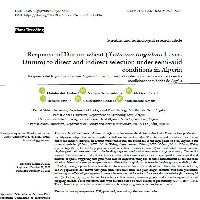Resumen
- In arid and semi-arid areas, drought is an important abiotic factor that limits Durum wheat production. Identifying genotypes tolerant to drought is a challenge for plant breeders. This study aimed to evaluate the effect of direct and indirect selection on Durum wheat under rain-fed conditions in the high plains of Sétif, Algeria. Four parental varieties (Ofanto, MBB, Mrb5, Waha), three crosses (Ofanto/MBB, Ofanto/Mrb5, Ofanto/Waha) representing the F5, F6, and F7 populations, and one cultivar (Bousselm, control) were cultivated. Pheno-morpho-physiological traits were measured at the heading stage and yield and its components at grain maturity. Our results showed that the response to direct selection was reflected in a significant increase in grain yield, economic yield, and number of spikes, suggesting that grain yield may be improved using one of these characteristics as the selection criterion. Selection by canopy temperature was affected by a significant decrease in the drought susceptibility index (-11.3 %), making it possible to obtain abiotic stress-resistant lines. The study of the relationships between F5, F6, and F7 populations has shown that grain yield, economic yield, and plant height correlate with each generation, indicating no effect of genotype-environment interaction, unlike others. Late selection revealed eight meaningful lines (L1, L8, L14, L28, L32, L35, L36, and L40) in the selection process, maintaining high production throughout different cropping seasons. These successful lines were selected based on traits related to productivity: Gr.YLD, Ec.YLD, NS. These characters provide the same information as breeding programs, according to our results.
